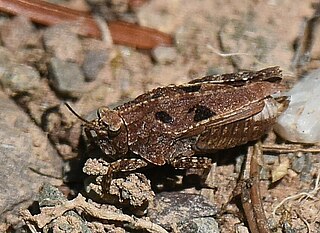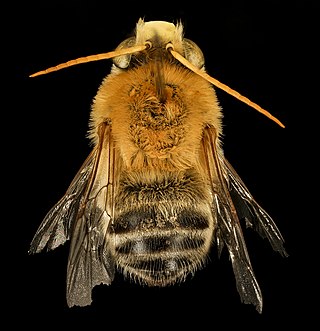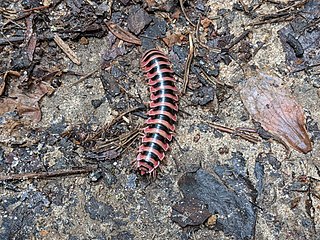
Chipmunks are small, striped rodents of Sciuridae, the squirrel family; specifically, they are ground squirrels (Marmotini). Chipmunks are found in North America, with the exception of the Siberian chipmunk which is found primarily in Asia.

Genus is a taxonomic rank above species and below family as used in the biological classification of living and fossil organisms as well as viruses. In binomial nomenclature, the genus name forms the first part of the binomial species name for each species within the genus.
Althaeus is a genus of pea and bean weevils in the beetle family Chrysomelidae. There are at least three described species in Althaeus.
Inscudderia is a genus of North American "cypress katydids" in the family Tettigoniidae. There are currently three described species in Inscudderia.
Hippopedon is a genus of band-winged grasshoppers in the family Acrididae. There are at least three described species in Hippopedon.

Chimarra is a genus of little black caddisflies in the family Philopotamidae. There are more than 630 described species in Chimarra.
Sphecodosoma is a genus of sweat bees in the family Halictidae. There are at least three described species in Sphecodosoma.

Protenor is a genus of broad-headed bugs in the family Alydidae. There are at least three described species in Protenor.
Ammobaenetes is a genus of sand-treader crickets in the family Rhaphidophoridae. There are at least three described species in Ammobaenetes.
Haematochiton is a genus of pleasing fungus beetles in the family Erotylidae. There are at least three described species in Haematochiton.
Bryelmis is a genus of riffle beetles in the family Elmidae. There are at least three described species in Bryelmis.
Trepidulus is a genus of band-winged grasshoppers in the family Acrididae. There are at least three described species in Trepidulus.

Nomotettix is a genus of pygmy grasshoppers in the family Tetrigidae. There are at least three described species in Nomotettix.

Martinapis is a genus of long-horned bees in the family Apidae. There are at least three described species in Martinapis.
Bradycinetulus is a genus of earth-boring scarab beetles in the family Bolboceratidae. There are at least three described species in Bradycinetulus.

Delochilocoris is a genus of dirt-colored seed bugs in the family Rhyparochromidae. There are at least three described species in Delochilocoris.

Semionellus is a genus of flat-backed millipedes in the family Xystodesmidae. There are at least three described species in Semionellus.
Selenocheir is a genus of flat-backed millipedes in the family Xystodesmidae. There are at least three described species in Selenocheir.
Decticita is a genus of shield-backed katydids in the family Tettigoniidae. There are at least three described species in Decticita.
Plagiostira is a North American genus of shield-backed katydids in the family Tettigoniidae. There are at least three described species in Plagiostira. It is the only genus in the monotypic tribe PlagiostiriniStorozhenko, 1994.







